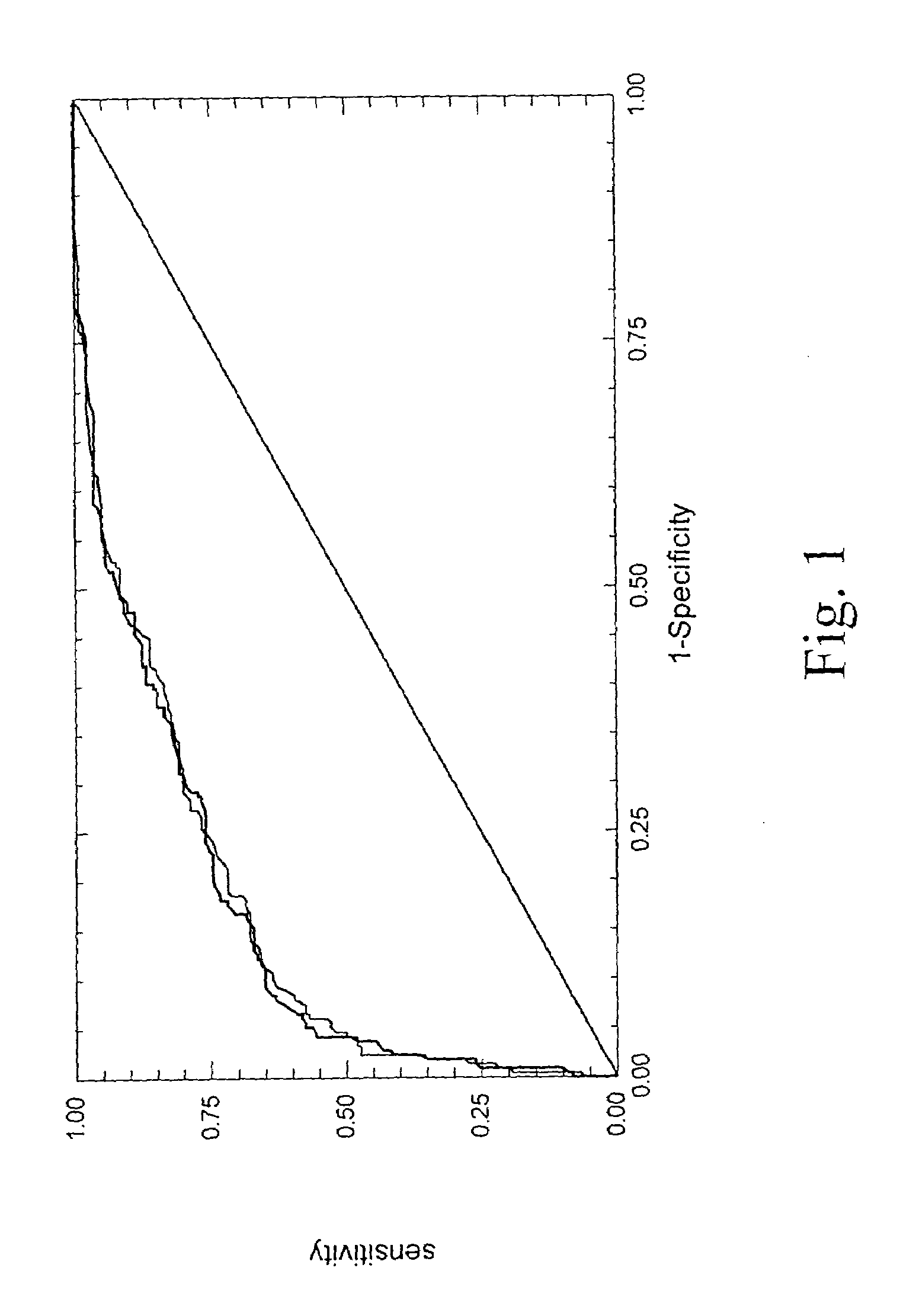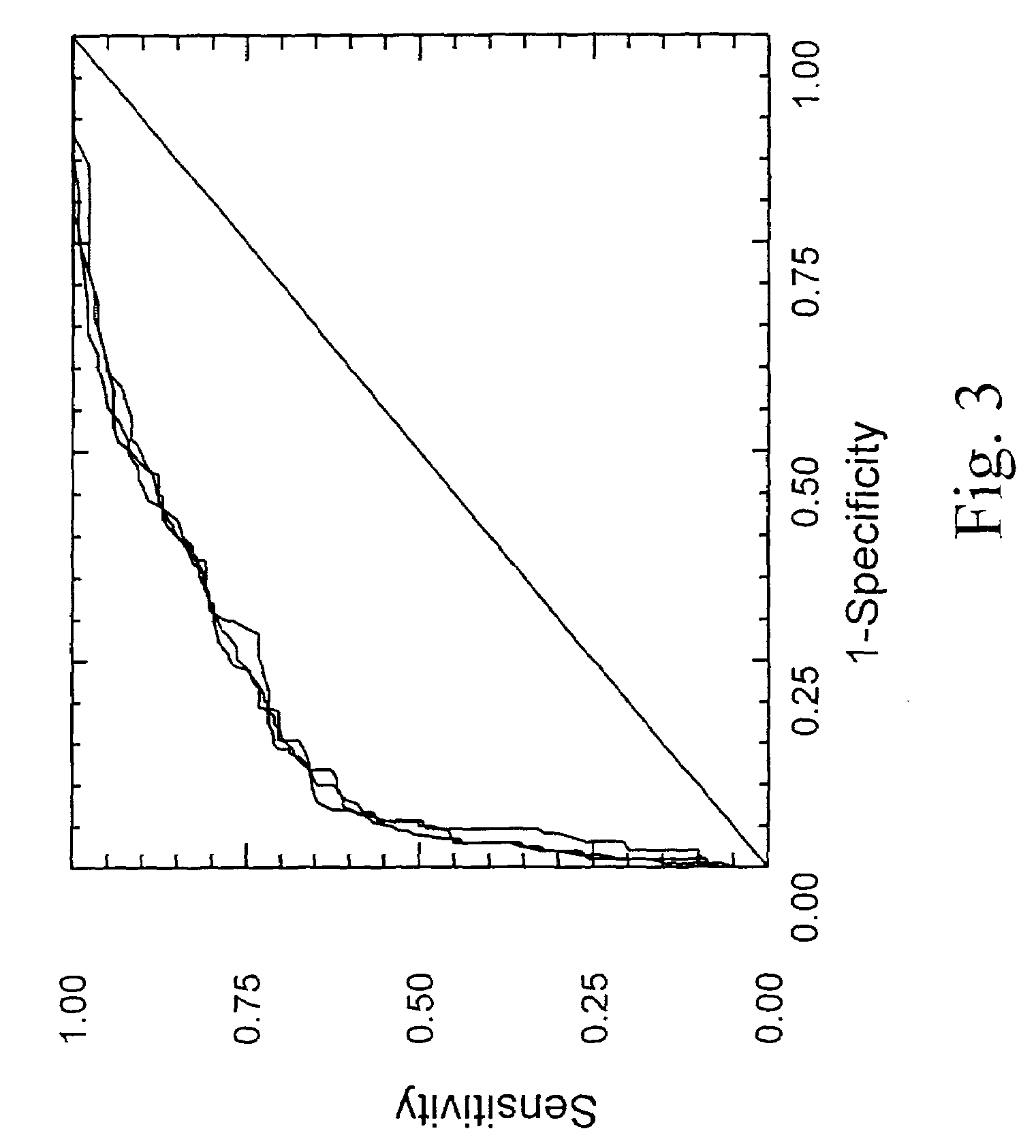Diagnosis method of inflammatory, fibrotic or cancerous disease using biochemical markers
a biochemical marker and inflammatory technology, applied in the field of diagnosis of inflammatory, fibrotic or cancerous disease using biochemical markers, to achieve the effect of reducing the number of biopsy indications, reducing the cost and the risk of biopsies
- Summary
- Abstract
- Description
- Claims
- Application Information
AI Technical Summary
Benefits of technology
Problems solved by technology
Method used
Image
Examples
example 1
Patients and Methods
[0107]1.1. Patients
[0108]Patients included in the study belonged to a single center cohort, named Hepatite C Pitie-Salpetriere, (DOSVIRC). This cohort included all the patients with hepatitis C (defined as a positive serology by at least a second generation ELISA test) followed in the liver and gastrointestinal unit of Pitie-Salpetriere Hospital, Paris, France, retrospectively before 1993 and prospectively afterwards (16). A specific questionnaire was filled out for each patient which contained 129 items including social-demographic-administrative data, risk factors, and at each visit clinical, biologic, virologic and treatment items, and histologic data when liver biopsy was performed. The duration of HCV infection was estimated from the date of transfusion or initial exposure to other parenteral sources, and it could not be calculated for patients with sporadic infection or those in whom the source of infection was unknown. Exclusion criteria were the presence ...
example 2
[0124]Statistical analysis used logistic regression and ROC curves (20). The analysis was performed on a first period (first year training period) and validated on the second period (validation period), cohort of patients as in Tables 1 and 4.
[0125]Then a final analysis was performed on the overall population combining the two periods (see tables 2 and 5).
[0126]According to the METAVIR scoring system, patients were divided into several groups.
[0127]The major endpoint was the identification of patients with significant fibrosis (F2, F3 or F4) versus patients without significant fibrosis (F0 or F1).
[0128]In secondary analyses patients were also divided according to activity grades: patients without significant activity (A0 or A1) and patients with histological activity (A2, or A3).
[0129]A group with non-significant histological features (A<2 and F<2) and a group of significant lesions (A≧2 and / or F≧2) were defined.
[0130]Finally a group with extensive fibrosis or ci...
example 3
Determination of the Logistic Function
[0140]A total of 422 patients with chronic hepatitis C were pre-included.
[0141]Depending of the number excluded for the following reasons (HIV coinfection, HBV coinfection and transplantation), of the impossibility of fibrosis staging was impossible in others, or the impossibility of dosage of at least one out of the 11 markers, total of 362 (1st study) or 339 (2nd study) patients with chronic hepatitis C were included in the study, as indicated in Tables 1 and 4, respectively.
[0142]There was no difference between the patients characteristics and biochemical markers between first and second sample (Tables 1 and 4). The overall prevalence of significant fibrosis was 40% (F0 17–18%, F1 42–43%, F2 19–20%, F3 8%, F4 12–13%), as determined by histology.
[0143]3.1. Diagnosis of Significant Fibrosis
[0144]The diagnostic values (area under the ROC curves) of each of the eleven biochemical markers are given in tables 2 and 5 as well as their independent as...
PUM
 Login to View More
Login to View More Abstract
Description
Claims
Application Information
 Login to View More
Login to View More - R&D
- Intellectual Property
- Life Sciences
- Materials
- Tech Scout
- Unparalleled Data Quality
- Higher Quality Content
- 60% Fewer Hallucinations
Browse by: Latest US Patents, China's latest patents, Technical Efficacy Thesaurus, Application Domain, Technology Topic, Popular Technical Reports.
© 2025 PatSnap. All rights reserved.Legal|Privacy policy|Modern Slavery Act Transparency Statement|Sitemap|About US| Contact US: help@patsnap.com



